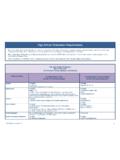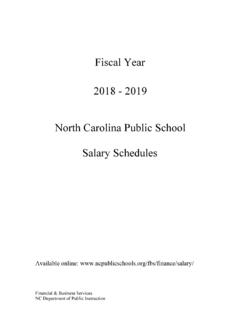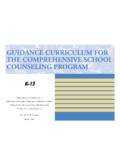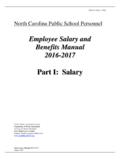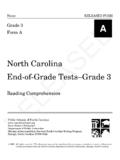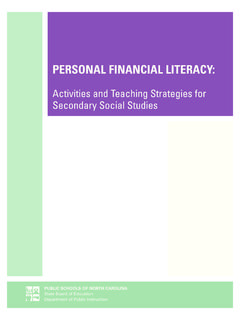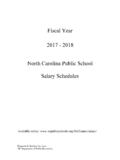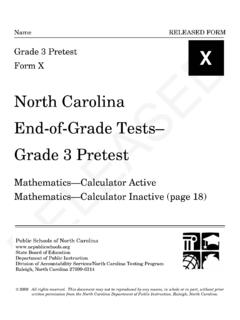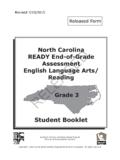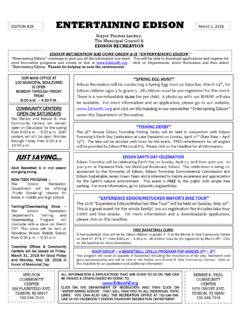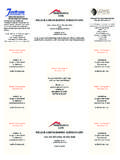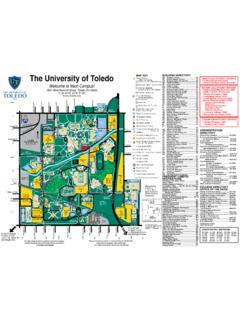Transcription of Chapter 7 - Portfolio Assessment
1 Chapter 7 - Portfolio Assessment What is a Portfolio ? A Portfolio is a purposeful collection of selective significant samples of student work accompanied by clear criteria for performance which evidence student effort, progress or achievement. A Portfolio is different from a folder in that it includes: o Explicit guidelines for selection o Comprehensible criteria o Clear objectives o Selective and significant pieces o Students' self-reflection pieces o Evidence of student participation in selection of content A Portfolio can exhibit the student' s, progress, and achievement in several areas.
2 The list below illustrates some of the items which might be housed in a student's foreign language Portfolio to give a complete view of what the student knows and is able to do. Figure 109 - Sample Portfolio entries work samples (graded and ungraded). compositions/essays journals tests pictures checklists projects performances audiotapes videotapes interviews observations formal scores self assessments student reflections Assessment , Articulation, and Accountability, 1999 178. Because the purpose for a Portfolio will determine some of the items to be included, teachers will want to customize portfolios based on their classroom needs.
3 Figure 110 - Pros and Cons of Portfolio Assessment . Pros 1. Provides tangible evidence of the student's knowledge, abilities, and growth in meeting selected objectives which can be shared with parents, administration and others 2. Involves a considerable amount of student choice - student-centered 3. Involves an audience 4. Includes a student's explanation for the selection of products 5. Places responsibility on the students by involving them in monitoring and judging their own work 6. Encourages a link between instructional goals, objectives, and class activities 7.
4 Offers a holistic view of student learning 8. Provides a means for managing and evaluating multiple Assessment for each student. The Portfolio provides the necessary mechanism for housing all the information available about a student's learning. It includes a variety of entries including test scores, projects, audio tapes, video tapes, essays, rubrics, self- assessments, etc. 9. Allows students the opportunity to communicate, present, and discuss their work with teachers and parents.. Assessment , Articulation, and Accountability, 1999 179.
5 Cons 1. Takes time 2. Present challenges for organization and management What Are the Kinds of Portfolio ? Several kinds of Portfolio can be organized. They are: o Showcase (to display the students best work to parents and administrators). o Outcome-based or Assessment (to fulfill requirements and goals set by district). o Working, process, or collection (ongoing, developmental). When to Start a Portfolio ? The Guide to Classroom Assessment suggests beginning Portfolio Assessment at the beginning of the year, reviewing the contents of each Portfolio on a regular basis (every month or two), meeting with students on a regular basis to review and discuss each student's work (1-4.)
6 Times a year). Teachers implementing Portfolio Assessment for the first time, may want to start small the first year with one classroom or may want to limit the use of Portfolio to the Assessment of one goal or one skill. Guidelines for Using Portfolios Identify purpose Select objectives Think about the kinds of entries that will best match instructional outcomes Decide how much to include, how to organize the Portfolio , where to keep it and when to access Assessment , Articulation, and Accountability, 1999 180. it Decide who selects the entries (the student, the teacher, both).
7 Set the criteria for judging the work (rating scales, rubrics, checklists) and make sure students understand the criteria. Review the student's progress Hold Portfolio conferences with students to discuss their progress 1. Identify Purpose Without purpose, a Portfolio is only a collection of student work samples. Different purposes result in different portfolios. For example, if the student is to be evaluated on the basis of the work in the Portfolio for admission to college, then, his final version of his best work would probably be included in the Portfolio .
8 Assessment , Articulation, and Accountability, 1999 181. In the foreign language class, portfolios can help teachers and students document growth over one year or over a period of several years. Furthermore they can facilitate the placement of students at the appropriate level once those students reach the next level of instruction. Figure 111 - Purposes For a Portfolio - How could you use it? Which of the following purposes are of particular importance for the Portfolio system you are developing? To show growth and change over time To show the process by which work is done as well as the final product To create collections of favorite or personally important work To trace the evolution of one or more projects/products To prepare a sample of best work for employment or college admission To document achievement for alternative credit for coursework To place students in the most appropriate course To communicate with student's subsequent teacher To review curriculum or instruction To conduct large-scale
9 Assessment To evaluate Program Other Assessment , Articulation, and Accountability, 1999 182. Northwest Regional Educational Laboratory, 1992. Assessment , Articulation, and Accountability, 1999 183. 2. Select Objectives The objectives to be met by students should be clearly stated. A list of communicative functions can be included for students to check when they feel comfortable with them and stapled to the inside cover. Students would list the title or the number of the sample(s). which address this function. Columns can be included for self- Assessment and/or for teachers to verify that competency.
10 Second language teachers can organize the Portfolio in a variety of ways. They can be organized around the seven goals of the North Carolina Second Language Studies Standard Course of Study: 1. Interpersonal Communication 2. Interpretive Communication 3. Presentational Communication 4. Cultures 5. Comparisons 6. Connections 7. Communities Portfolios also can be organized according to the five C's of the national standards or according to the selected objectives addressing one skill such as writing. The selected objectives will be directly related to the stated purpose for the Portfolio .
